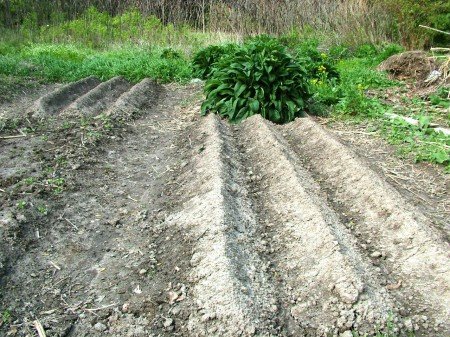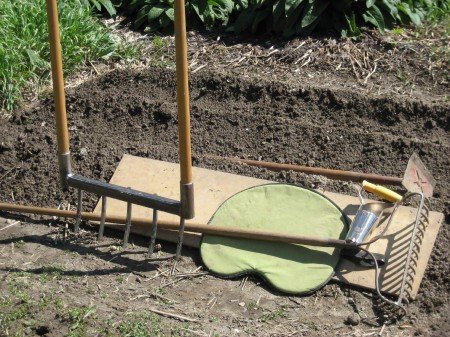I tried something new (for me) this year in planting my potatoes. Geoff mentioned this method to me years ago and I never got around to trying it. I kind of forgot that it was he who told me, but he was quick to remind me when I showed him what I did. The logic is simple. Plant your potatoes at the bottom of a trench, then hill up the dirt from the ridges of the troughs around the plants as they grow.
Potatoes only grow up, that is, their tubers won’t go down deeper than the mother spud used as a seed start, so hilling is a common practice to give the potatoes deeper soil to grow in and all kinds of methods are used to create the hills. In years past I’ve never bothered to hill my potatoes. I just planted them deep in my soft raised beds and hoped for the best, which was usually okay. We’ll see if we get more production this year.
To create the troughs I first thoroughly broke up the beds with my broadfork. I did two passes with the fork, first going from the center to the edge on each side of the bed, then moving along the length of the bed. Breaking the soil in both directions made it easy to rake up the beds into troughs with a steel rake. I put the finishing touches on the troughs to get them mounded as high as possible using a concrete workers draw hoe that I found at a garage sale years ago. It comes in handy for exactly this purpose.
Then it was down on my hands and knees, using my small planting board so I didn’t destroy the edges of the bed, to get the potatoes into the bottoms of the trenches. I used a bulb planter to put holes as deep as possible and planted the potato seeds, which I had earlier cut in half and allowed to dry, spaced roughly a foot apart. This is all new for me, we’ll see what happens.
When the potatoes send up their sprouts from the bottom of the trench and and get about six inches high, I’ll pull soil from the middle ridge and mound up soil around the individual plants. As the plants get taller, I’ll use the soil from the outer ridges to get as much soil surrounding the individual plants as possible. I may even use some mulch, I’m thinking of straw mixed with soil, to get the mounded plants as tall as possible. The plants should be setting more tubers as they grow upwards and the harvest should increase significantly depending on how good a job I do of building the mounds.
One of the two beds is planted with Adirondack Blue, a blue fleshed potato that we’ve grown before and like a lot. The other is Carola, a yellow potato that I have not grown previously. I still have to get in a bed of Rose Finn Fingerlings that I have seed for and I’ll probably plant a red skinned potato of some type, as well.
It’s not at all late to still plant potatoes, in fact you have a very wide window of opportunity with this crop. The grower I bought my seed from actually plants his crop in June. He says that gives him two advantages – a later harvest means a longer period for storage, important as he’s selling seed, and he says he has much less problem with potato beetles. I’ve planted potatoes very late several times, too. Only because I was behind in my garden tasks, not for any scientific reason, but I’ve still had good crops. I’ll let you know how this method turns out for me.



We like to have the small red potatoes to cook in our green beans. I read about growing them in a garbage can similar to what you are doing. As the sprouts grow, I will cover them with more soil. I was late getting them planted for our area but will keep posting their progress
Nice article!
I use the “Post Hole Digger” method, and people who have seen it love.
I dig a hole twelve inches deep( next hole twelve inches from the edge of the last hole) sprout the potatoes (called chitting) plant the seed potatoes at the bottom of the hole then cover with about three inches of soil, as the plant grows through, I keep sprinkling soil over as the plant grows up the hole until level or slightly higher. No need to earth up the potatoes, they already have 12 inches below ground to set tubers I always get a good crop.
Geoff Bray
Tinton Falls NJ